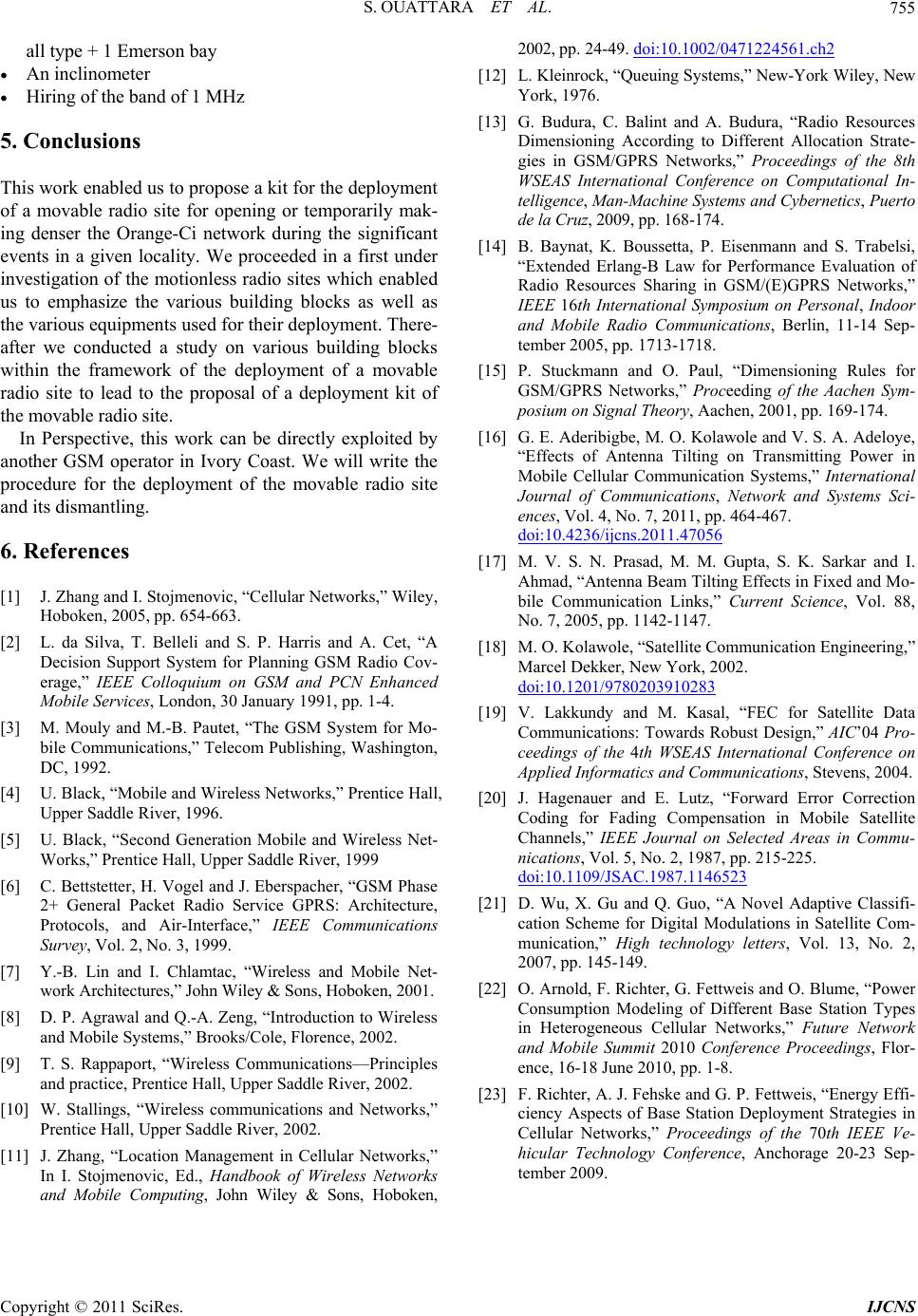
S. OUATTARA ET AL.
Copyright © 2011 SciRes. IJCNS
755
all type + 1 Emerson bay
An inclinometer
Hiring of the band of 1 MHz
5. Conclusions
This work enabled us to propose a kit for the deployment
of a movable radio site for opening or temporarily mak-
ing denser the Orange-Ci network during the significant
events in a given locality. We proceeded in a first under
investigation of the motionless radio sites which enabled
us to emphasize the various building blocks as well as
the various equipments used for their deployment. There-
after we conducted a study on various building blocks
within the framework of the deployment of a movable
radio site to lead to the proposal of a deployment kit of
the movable radio site.
In Perspective, this work can be directly exploited by
another GSM operator in Ivory Coast. We will write the
procedure for the deployment of the movable radio site
and its dismantling.
6. References
[1] J. Zhang and I. Stojmenovic, “Cellular Networks,” Wiley,
Hoboken, 2005, pp. 654-663.
[2] L. da Silva, T. Belleli and S. P. Harris and A. Cet, “A
Decision Support System for Planning GSM Radio Cov-
erage,” IEEE Colloquium on GSM and PCN Enhanced
Mobile Services, London, 30 January 1991, pp. 1-4.
[3] M. Mouly and M.-B. Pautet, “The GSM System for Mo-
bile Communications,” Telecom Publishing, Washington,
DC, 1992.
[4] U. Black, “Mobile and Wireless Networks,” Prentice Hall,
Upper Saddle River, 1996.
[5] U. Black, “Second Generation Mobile and Wireless Net-
Works,” Prentice Hall, Upper Saddle River, 1999
[6] C. Bettstetter, H. Vogel and J. Eberspacher, “GSM Phase
2+ General Packet Radio Service GPRS: Architecture,
Protocols, and Air-Interface,” IEEE Communications
Survey, Vol. 2, No. 3, 1999.
[7] Y.-B. Lin and I. Chlamtac, “Wireless and Mobile Net-
work Architectures,” John Wiley & Sons, Hoboken, 2001.
[8] D. P. Agrawal and Q.-A. Zeng, “Introduction to Wireless
and Mobile Systems,” Brooks/Cole, Florence, 2002.
[9] T. S. Rappaport, “Wireless Communications—Principles
and practice, Prentice Hall, Upper Saddle River, 2002.
[10] W. Stallings, “Wireless communications and Networks,”
Prentice Hall, Upper Saddle River, 2002.
[11] J. Zhang, “Location Management in Cellular Networks,”
In I. Stojmenovic, Ed., Handbook of Wireless Networks
and Mobile Computing, John Wiley & Sons, Hoboken,
2002, pp. 24-49. doi:10.1002/0471224561.ch2
[12] L. Kleinrock, “Queuing Systems,” New-York Wiley, New
York, 1976.
[13] G. Budura, C. Balint and A. Budura, “Radio Resources
Dimensioning According to Different Allocation Strate-
gies in GSM/GPRS Networks,” Proceedings of the 8th
WSEAS International Conference on Computational In-
telligence, Man-Machine Systems and Cybernetics, Puerto
de la Cruz, 2009, pp. 168-174.
[14] B. Baynat, K. Boussetta, P. Eisenmann and S. Trabelsi,
“Extended Erlang-B Law for Performance Evaluation of
Radio Resources Sharing in GSM/(E)GPRS Networks,”
IEEE 16th International Symposium on Personal, Indoor
and Mobile Radio Communications, Berlin, 11-14 Sep-
tember 2005, pp. 1713-1718.
[15] P. Stuckmann and O. Paul, “Dimensioning Rules for
GSM/GPRS Networks,” Proceeding of the Aachen Sym-
posium on Signal Theory, Aachen, 2001, pp. 169-174.
[16] G. E. Aderibigbe, M. O. Kolawole and V. S. A. Adeloye,
“Effects of Antenna Tilting on Transmitting Power in
Mobile Cellular Communication Systems,” International
Journal of Communications, Network and Systems Sci-
ences, Vol. 4, No. 7, 2011, pp. 464-467.
doi:10.4236/ijcns.2011.47056
[17] M. V. S. N. Prasad, M. M. Gupta, S. K. Sarkar and I.
Ahmad, “Antenna Beam Tilting Effects in Fixed and Mo-
bile Communication Links,” Current Science, Vol. 88,
No. 7, 2005, pp. 1142-1147.
[18] M. O. Kolawole, “Satellite Communication Engineering,”
Marcel Dekker, New York, 2002.
doi:10.1201/9780203910283
[19] V. Lakkundy and M. Kasal, “FEC for Satellite Data
Communications: Towards Robust Design,” AIC’04 Pro-
ceedings of the 4th WSEAS International Conference on
Applied Informatics and Communications, Stevens, 2004.
[20] J. Hagenauer and E. Lutz, “Forward Error Correction
Coding for Fading Compensation in Mobile Satellite
Channels,” IEEE Journal on Selected Areas in Commu-
nications, Vol. 5, No. 2, 1987, pp. 215-225.
doi:10.1109/JSAC.1987.1146523
[21] D. Wu, X. Gu and Q. Guo, “A Novel Adaptive Classifi-
cation Scheme for Digital Modulations in Satellite Com-
munication,” High technology letters, Vol. 13, No. 2,
2007, pp. 145-149.
[22] O. Arnold, F. Richter, G. Fettweis and O. Blume, “Power
Consumption Modeling of Different Base Station Types
in Heterogeneous Cellular Networks,” Future Network
and Mobile Summit 2010 Conference Proceedings, Flor-
ence, 16-18 June 2010, pp. 1-8.
[23] F. Richter, A. J. Fehske and G. P. Fettweis, “Energy Effi-
ciency Aspects of Base Station Deployment Strategies in
Cellular Networks,” Proceedings of the 70th IEEE Ve-
hicular Technology Conference, Anchorage 20-23 Sep-
tember 2009.